‘Art does not reproduce what we see; it merely makes it visible...’
Naturally, the famous artist of Swiss origin Paul Klee is talking about his painting in this quotation; however, this statement can in fact refer to each translation of the real world or, in our case, of spatial reality into any medium which transfers messages about this world. The carrier of this message can be either the written word, or a still or film camera – with all the developed possibilities of post-processing today, or again a drawing on paper, in other words, a colouristic presentation. Each of these techniques for transferring messages of course demands certain levels of contemplative activity, very different ones, and the final result always represents above all a personal narrative of the person who mediates this message.
This time we are talking about a line drawn by hand and its relation to a line drawn with a computer. Namely, the statement that the computer draws instead of us is more and more often repeated, and frequently we have the impression that words that are repeated gradually become true. It is repeated that the computer is more accurate, faster, more skilful... These claims have some truth in them, but still, some truth...
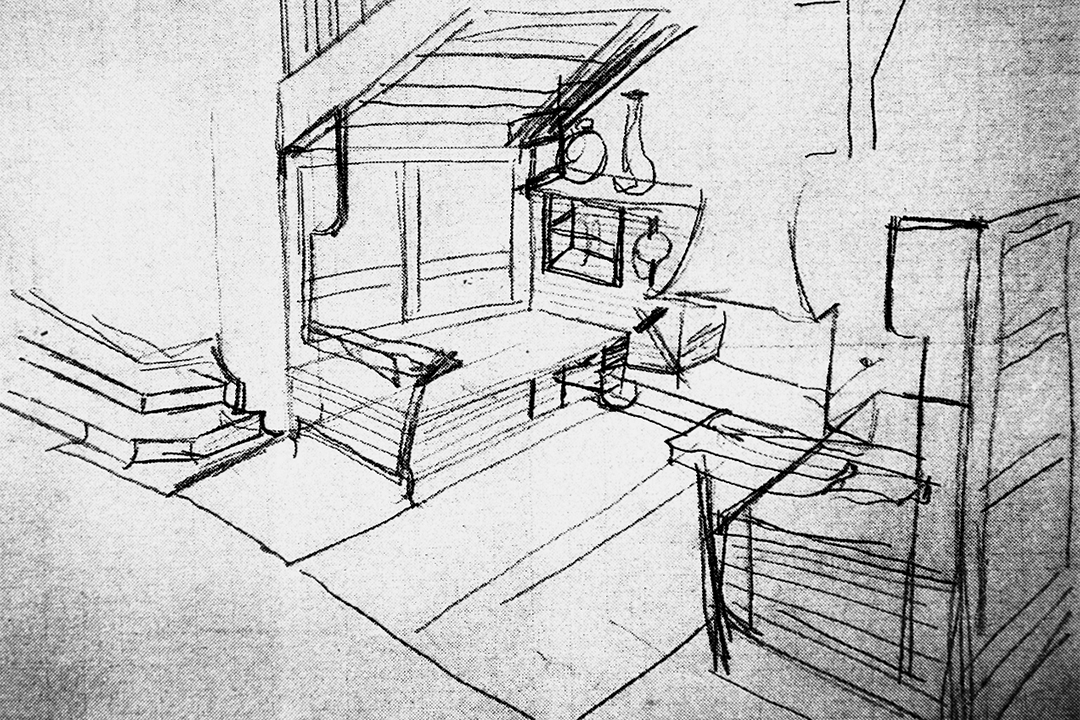
With these thoughts, I would like to draw attention to the importance of drawing in architecture. Of course, the purpose of my text is certainly not an appeal in terms of replacing computer-generated drawing by drawing with the help of a technical pen; it rather represents an invitation to contemplate what a drawing executed by hand carries within! Ms Martha Kohen from the School of Architecture at the University of Florida motivated me to transfer my occasional loud contemplations to this text. On the other hand, there were also opportunities which we notice at different European universities in the process of the current ‘coming closer together’ within the Bologna process. And finally, there is also of course leafing through contemporary architectural magazines.
What a lot of articles have already been written on the possibilities which a computer provides! Of course, it frees us from construing complex tasks of descriptive geometry; with the help of simple programmes, we stroll over three-dimensional models, quickly drawn, which we can then colour with pigments, equip with materials, light, reflexes...
Here, we almost forget that the hand is still important when we initially decide what we will present and what it will look like, and it is guided by a certain head, certain thoughts...
In his essay ‘The Eyes of the Skin’, Juhani Pallasmaa talks exactly about that: ‘The computer is usually seen as a solely beneficial invention, which liberates human fantasy and facilitates efficient design work. I wish to express my serious concern in this respect, at least considering the current role of the computer in the design process. Computer imaging tends to flatten our magnificent, multi-sensory, simultaneous and synchronic capacities of imagination by turning the design process into a passive visual manipulation, a retinal journey. The computer creates a distance between the maker and the object, whereas drawing by hand as well as model-making put the designer into a haptic contact with the object or space. In our imagination, the object is simultaneously held in the hand and inside the head, and the imagined and projected physical image is modelled by our bodies. We are inside and outside the object at the same time. Creative work calls for a bodily and mental identification, empathy and compassion.’
Many authors emphasize that we humans are as much historical as we are biological beings. Connectedness of thoughts, in other words intellect and hand, or in other words action, exists on several levels – from conscious to subconscious. We still do not know the number of inter-reactions which do not pass through the consciousness at all. We could compare the relation between drawing by hand and drawing with a computer to the difference between unscripted speech and reading a text written in advance. They are not only different experiences of the same content, but it is far more a case of different contact between the speaker and the listener. A written speech remains the same as it was written; it is a finalized work. Reading is in a way repetition of the same, of something that already exists...
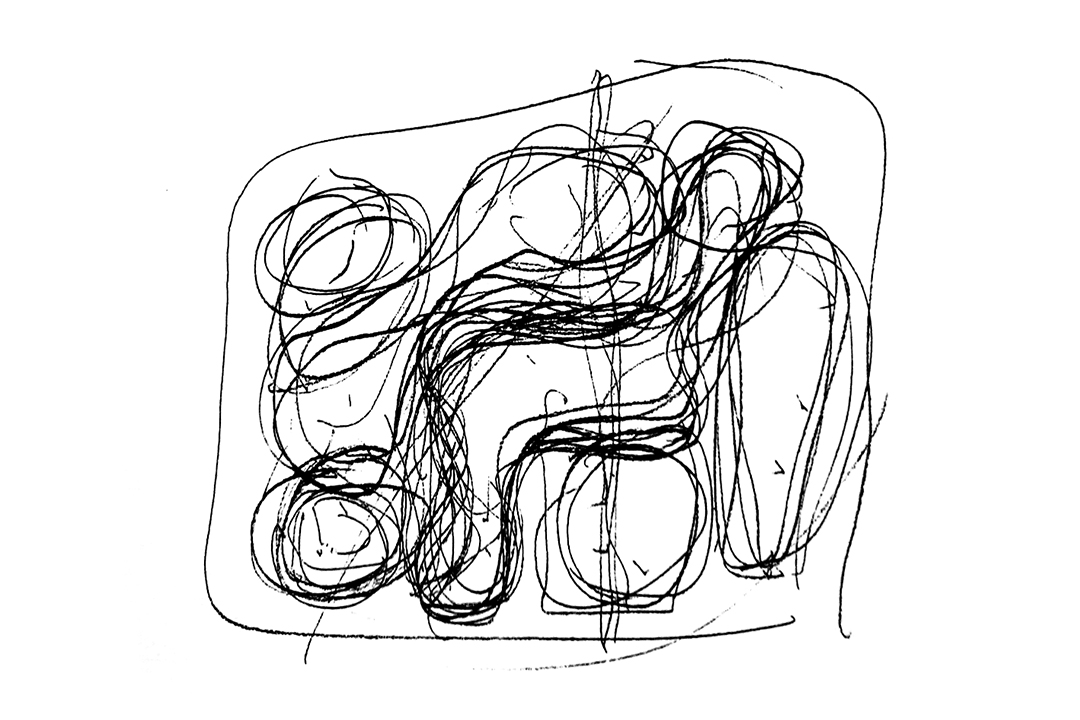
In unscripted speech, we form the spoken words even during speaking, although we have already prepared in advance the thoughts we wish to express. Appetito viene mangiando! We modify our speech according to the atmosphere that dominates, or we make it more precise in relation to aspects which we have not even contemplated until that time. There is always the possibility of at least choosing a better way, if not entirely turning around the direction of the narrative!
In this sense, we could draw a parallel with thinking about a drawing made by hand. There is a similarity with freehand drawing, as well as with the entirely technical side of designing by hand. Putting measures on the draft is also immanent to a drawing by hand. We are witnessing a certain integral process: first, there is a line, a contour – here, our drawing of a line by hand follows the flow of thinking, reacts to our every change of these thoughts, in other words, this is a process which enables a far greater number of solutions; it chooses a solution at the end of the process of drawing the line. And then, there is dimensioning, equipping the drawing with measures; in the process of drawing a design by hand, dimensioning is an integral part of the process – the measure is set where it is basically needed; namely, it belongs to the very object in which we put ourselves through our drawing, as Pallasmaa says. Here, and we are not even aware of it, is at work the process of reducing to the necessary, or the process of needed abstraction which is to a large extent entirely subconscious! The final purpose is still the transfer of an idea, a design which carries an idea and is something totally exact, to a rough construction site where there is never such precision as in a drawing and yet, it follows similar regularities. If we observe the process on the construction site, it becomes totally obvious which written measure on the drawing is significant and which is not. Here, we are not at all talking about often unnecessary measures, which appear unnoticed in the plans during drawing with a computer, about shortcomings to which we have to pay special attention, about consequences of copy-paste possibilities which demand a particular presence of the spirit.
When we draw a space by hand, we draw what we consciously know and what in our subconsciousness is connected with this space and thus we are projecting our desires which emerge during drawing into the drawing. In contrast to this, we merely draw history with a computer, what has already been conceived or even thought out, designed completely (we are reading a speech that has already been written). Thus, we let slip all incidental associations, doubts, as well as sudden unconscious inspirations... Only a view of the completed image remains, contemplation is only subsequent, after we have already forgotten a lot (of which we of course are not aware!).
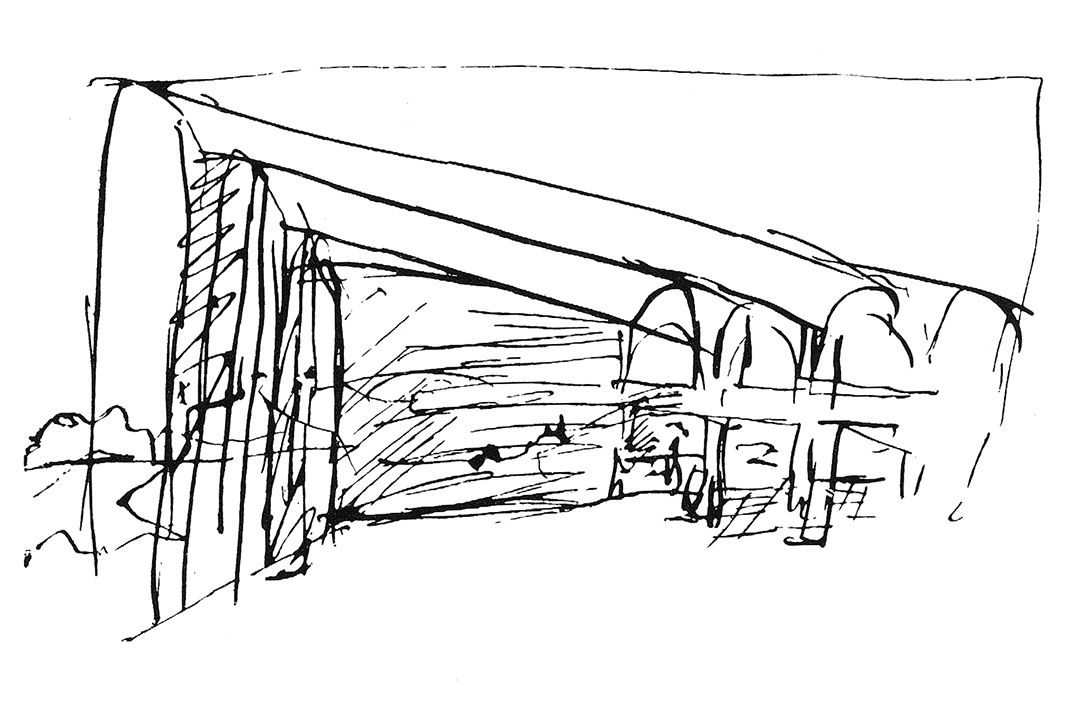
In his book The Craftsman (Yale University Press, New Haven, London, 2008), Richard Sennett talks, among other things, precisely about the phenomena and difficulties which were the motive for this text.
He mentions the fact that we perceive space directly through perception of the terrain through the drawing, we could say analogously, without any need for conversion; with a computer, we determine it digitally, we need immediate intellectual operation; namely, numbers as such do not represent anything to us. He talks about the problem of having a feeling for scale, which arises during drawing with a computer. He warns of the feeling for material which we also transfer into a drawing directly, so to say unconsciously, while drawing by hand, in other words, we find the sensation of touching material familiar! Certainly, this author cannot ignore the predetermination of computer drawing which does not only aggravate the very reading of a design, but also restricts creative solutions due to the numberless details both in the process of developing a project, as well as during its implementation.
He writes about the fact that in case of separation of the hand and head, it is the head that suffers, and about the fact that the spoken word in relation to any kind of instruction is more efficient than any written direction. Kant already talked about the hand in fact representing a window into the brain! He quotes Charles Bell who, in his book The Hand which he published long ago in 1833, talks about the consciousness gaining a truer interpretation by touch than by gaze! This is exactly what Juhani Pallasmaa talks about in his book The Eyes of the Skin! And I think that the most important thing here is warning of the fact that the brain also developed and grew larger due to the work of the hands! As well as vice versa! Are we aware of these connections to a sufficient extent?
Carlo Scarpa used to recommend, as professor to his students, drawing with a hard pencil on soft paper (!)... A line that is abandoned, one we see drawn in a less decisive manner beneath the one drawn more decisively, made bold and final, and also one which, when erased, is recognized on the paper as a groove, significantly contributes to the well-foundedness and expression of the final line. He talks about the manner in which contemplation on the subject which was formed by the final result developed. He provides this result with profoundness and in a way leaves open possibilities of conceiving consequent possible supplements.
The line is as closely connected with the so-called discursive thinking of an individual as it is with the intuitive process of thinking, in other words, with that segment of thinking which we do not follow directly consciously, but which has a significant share in our reactions. When we draw by hand, when we make a sketch on a new sheet, already here a certain world appears (the surroundings in which our intervention should occur, a building, space to which we would attach ourselves in the project); we inadvertently observe what we elaborate – the house has axes, the space certain sequences..., that the new which we want to add (to the house or space) at first inadvertently listens to the inner rhythm in our lines of what we have come across. Even before we start to observe in an entirely analytical manner what we have found, we enter this new world, we become part of this new world!
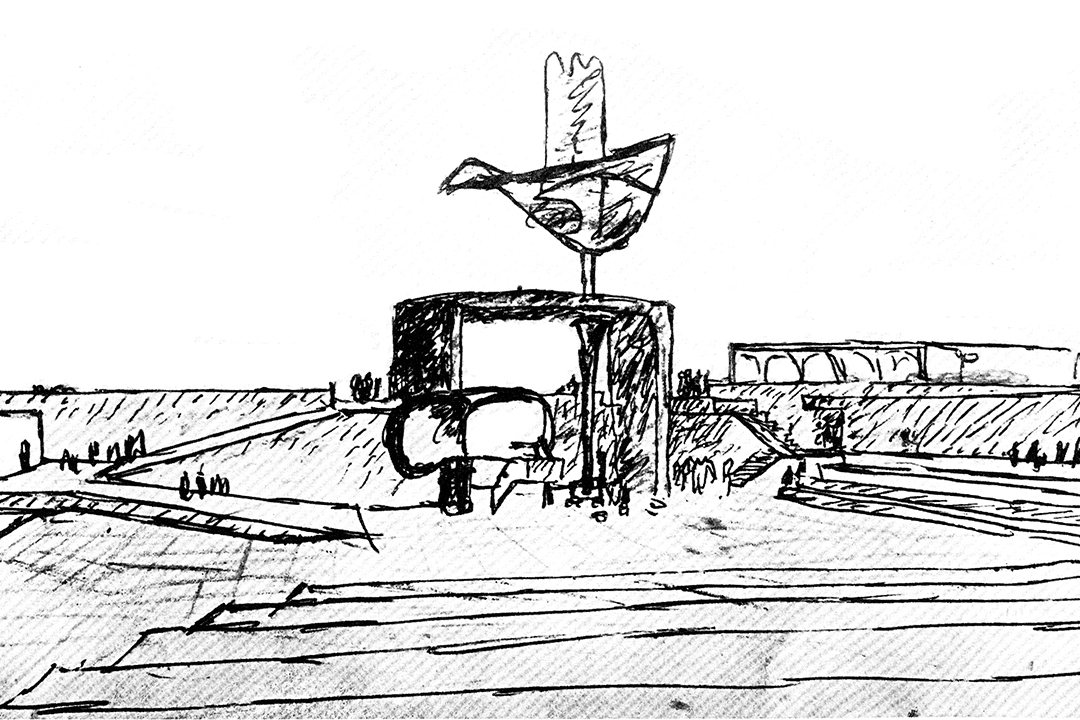
A line can be refined, polished, professional, skilled, and it can also be simple, at first sight meandering, ungainly, and yet we soon notice that its narrative, its power is somewhere beyond it. Its narrative is quite complex. We say, this line ‘falls into place’. In fact, this same line talks about all what is behind it, it talks about the idea that guided it, or even better, it shows us how this idea formed (itself)...
We could compare the coming into being, the generation of a line with what is hidden in the excerpt of the text ‘Lost in the Reality of Cosmos’, written by Niko Jež as the foreword to the novel Cosmos by Witold Gombrowicz: ‘It is not an ordinary novel that tells a story, but it is a novel about how a story comes into being, how its truthfulness is created. From different statements by the author, we can conclude that it emerges always and again when repeating certain inadvertently revealed and illuminated motifs which are associatively related with similar motifs. The basic plot is formed in the process of narrating, it emerges from certain relations, similarities, comparative positions. The narrative process, therefore, seeks principles of orderliness in reality, its hierarchy of meaning.’
A line is a carrier of something else: it is a carrier of personality, personal expression. Everyone has (carries) a line within himself or herself. When this line will be drawn depends, of course, only on the person who is destined to draw it. No one else can draw this line. This line is above all the handwriting of an individual person. Like a fingerprint, it speaks exactly about this person. Through it, we recognize the voice, skin colour, passion... of this person exactly. By denying the role and value of this line, we will deny its entire richness. We are not talking merely about an abundance we surrender. With these layers of line, a draft is generated!
The individuality of a drawing by hand after all also talks about a personal feature of the architectural design of an individual author:
- the calculated and reserved, reduced to the minimum, seemingly almost ungainly drawing by Adolf Loos talks through the author’s architecture about density and the extreme realized usage of space without remnants, each and every possible surplus of a volume is already transferred into another ambience...
- the vehement and exceptionally painting-like stroke of Le Corbusier’s drawing is reflected in the strokes of his forms and volumes and, in his case so pronounced, catching the light in chiaroscuro of his architecture.
- the explorative graphisms of Carlo Scarpa’s sketches are reflected, naturally, in his architecture which is characterized by prominently layered surfaces which project one onto another in a superimposed manner.
- the clear initial strokes in Edvard Ravnikar’s drawings, which never conclude in the interplay (and perhaps their intersections are determined in the best case), reflect contemplation and concept, we could say a system of composition within which the final solution is always open, surrendered to the temporal movement, inclined to changes and additions. We follow this character of the drawing from the plan on an urbanistic scale, which results in a slight blending with the surroundings in the realization, to the details of the so characteristic open endings of his architecture.
- the childlike, simple and concentrated drawings by the Sejima–Nishizawa School tandem and their pupils (Ishigami...) which radiate with tenderness, reservedness, but certainly the abstractness of Zen as well (a huge contemplative drive in the tradition of Japanese calligraphy and drawing), naturally find reflection in their architecture. We could list such examples forever...
We can find similarities in any other branch of the arts as well. It is certainly not technique with which a work of art is built. To the question why, as a top pianist, he never plays pieces by the supreme composer for the piano, Chopin, Glenn Gould replies, of course with his characteristic vehemence, that he does not care about the perfect technique which is possible to achieve on a musical instrument; he plays authors who want to express something more with music!
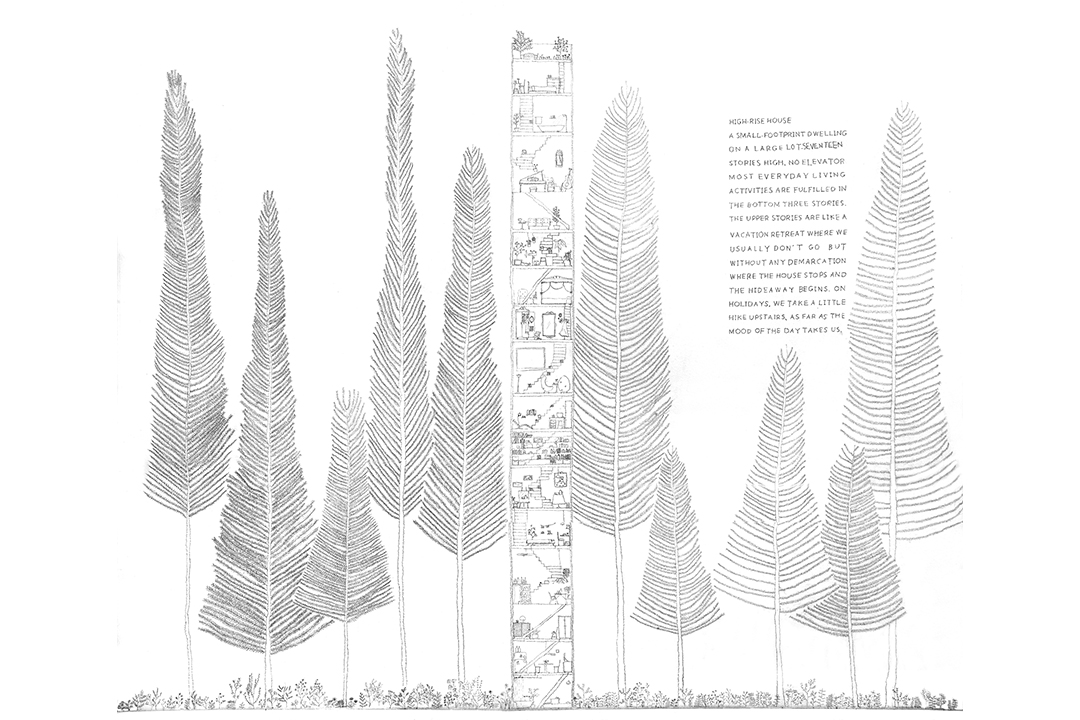
Or Brane Kovič, who talks about first-rate photography, a medium for which there is a saying that it never lies, in the article ‘Kingdom of Still Lifes’ (about the photography of Boris Gaberščik, Oris 57/2009): ‘The paradox of photography is in reality manifested outside the photographer’s skill, behind chemical reactions, and the knowledge necessary for these reactions to be developed properly, to lead to the desired result. The photographer, however, sees a thing, motif or arrangement which he has decided to shoot, but he is obliged to blindness just like the absolute seer – he cannot see the characters he watches through the lens in their material embodiment, in the one-dimensionality of their black and white or tinted photograph. This is the reason why the author’s ability to create mental images, behind which are personal stories, memories and experiences, is so much more efficient in creating photographs.’
I read contemporary Portuguese texts about architecture and I compare them with numerous texts in other languages which appear in today’s magazines... Namely, only rare magazines are able to resist the flood of contemporary architecture which day after day brings new forms, brain products, which only a computer is of course able to draw. Along with these presentations, naturally, a flood of complicated explanations and dictions are involved, which have to describe complicated structures. Nevertheless, to tell the truth, these texts are often not especially long, they talk about architecture which is built (conceived) primarily for communication with its own image. The layouts and cross sections of these presentations are often not (any longer) significant, and therefore their presence does not disturb publication.
This fact carries in itself a danger of delivering general judgements which certainly are never in place. A conclusion arises too quickly and it is similar to urges to break industrial machines which were assumed to be the cause of working-class misery in the 18th century. As if the revelation of computer drawing surprised us, although it has been (in our case) in general use for approximately 20 years! The thing is that the right place for drawing by hand should be found as well as for drawing made with computers with all its possibilities.
The earlier mentioned texts that originate from the furthest European West are expressed in exceptionally simple words and sentences. And yet, they talk about the peaks that world architecture is reaching at the present time! These are conceived by hand. For transfer to the construction site (and for publishing as well!) they are drawn with a computer...
Let us go back to the motivations for these thoughts: apart from being urged by the professor from the University in Florida, here is also the fact that today we are faced with the serious task of understanding the importance of individuality, not only in the European schools of architecture, which today some want so much to bring together and to equal terms, but also in architecture in general.